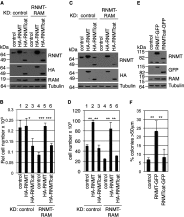Human cap methyltransferase (RNMT) N-terminal non-catalytic domain mediates recruitment to transcription initiation sites
- PMID: 23863084
- PMCID: PMC3778707
- DOI: 10.1042/BJ20130378
Human cap methyltransferase (RNMT) N-terminal non-catalytic domain mediates recruitment to transcription initiation sites
Abstract
Gene expression in eukaryotes is dependent on the mRNA methyl cap which mediates mRNA processing and translation initiation. Synthesis of the methyl cap initiates with the addition of 7-methylguanosine to the initiating nucleotide of RNA pol II (polymerase II) transcripts, which occurs predominantly during transcription and in mammals is catalysed by RNGTT (RNA guanylyltransferase and 5' phosphatase) and RNMT (RNA guanine-7 methyltransferase). RNMT has a methyltransferase domain and an N-terminal domain whose function is unclear; it is conserved in mammals, but not required for cap methyltransferase activity. In the present study we report that the N-terminal domain is necessary and sufficient for RNMT recruitment to transcription initiation sites and that recruitment occurs in a DRB (5,6-dichloro-1-β-D-ribofuranosylbenzimidazole)-dependent manner. The RNMT-activating subunit, RAM (RNMT-activating miniprotein), is also recruited to transcription initiation sites via an interaction with RNMT. The RNMT N-terminal domain is required for transcript expression, translation and cell proliferation.
Figures






References
-
- Topisirovic I., Svitkin Y. V., Sonenberg N., Shatkin A. J. Cap and cap-binding proteins in the control of gene expression. Wiley Interdiscip. Rev.: RNA. 2011;2:277–298. - PubMed
-
- Shuman S. What messenger RNA capping tells us about eukaryotic evolution. Nat. Rev. Mol. Cell Biol. 2002;3:619–625. - PubMed
Publication types
MeSH terms
Substances
Grants and funding
LinkOut - more resources
Full Text Sources
Other Literature Sources
Miscellaneous

